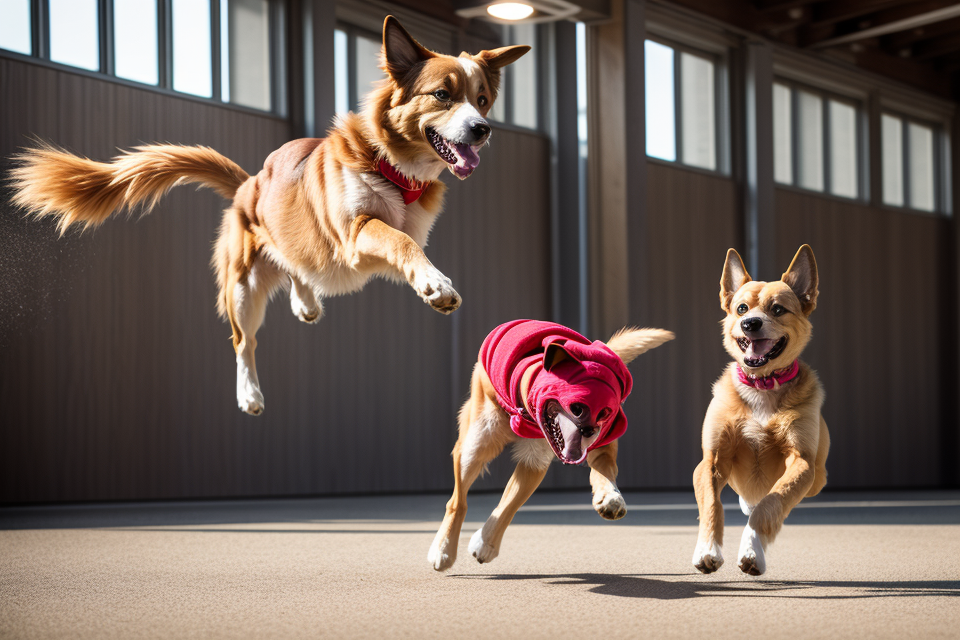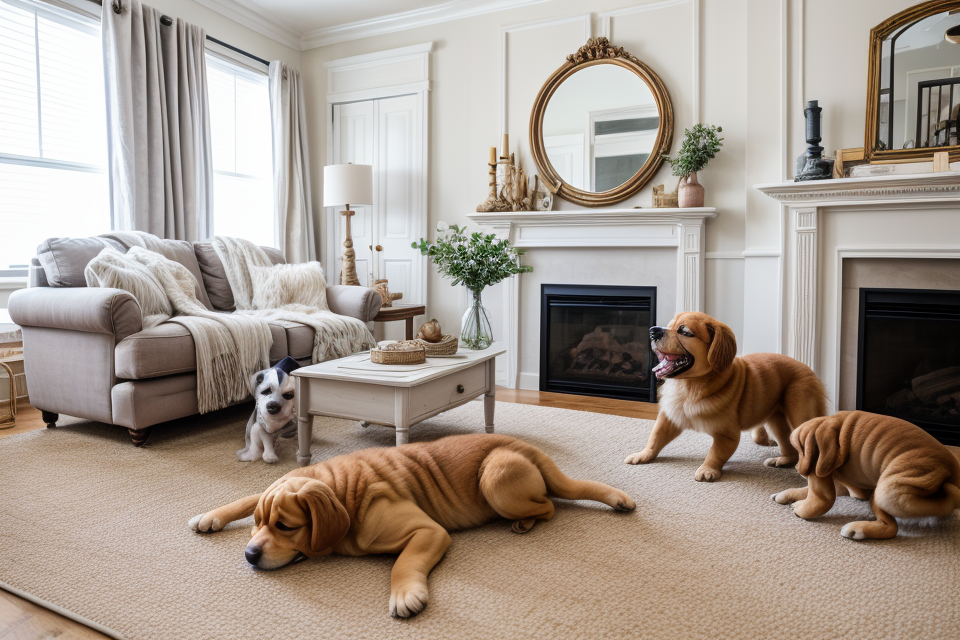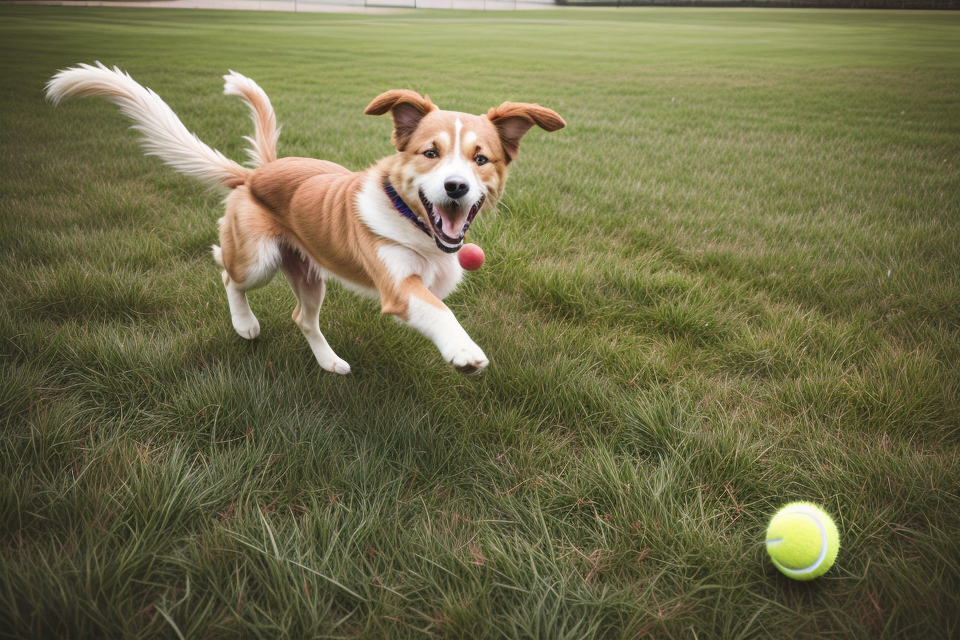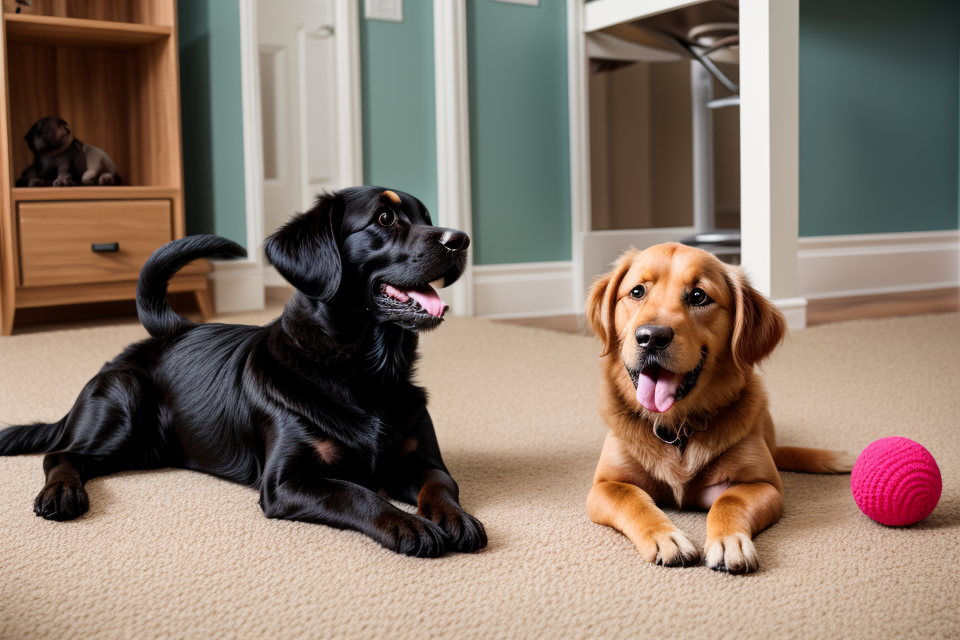Is your furry friend a high-drive dog that needs constant mental and physical stimulation? Then it’s time to get them the best training toys that will keep them engaged and happy! High-drive dogs are full of energy and need toys that will challenge their minds and bodies. In this article, we will explore the best training toys for high-drive dogs, from interactive puzzles to tough chew toys. We’ll also provide tips on how to choose the right toys for your high-drive dog’s unique needs and personality. So, let’s get started and find the perfect toy to keep your high-drive dog happy and healthy!
High drive dogs are often energetic and require more mental and physical stimulation to prevent destructive behavior. The best training toys for high drive dogs are those that challenge their mind and body, providing mental stimulation through interactive games and physical stimulation through activities like fetch and agility training. Some of the best toys for high drive dogs include puzzle toys that require problem-solving skills, tug toys that encourage social play and bite inhibition, and interactive scent work toys that provide a challenge and promote positive reinforcement. It’s important to provide variety in the toys and activities to keep the dog engaged and prevent boredom. It’s also important to supervise the dog during playtime and ensure they are not becoming overly excited or aggressive. Consulting with a professional dog trainer or behaviorist can also provide valuable insight and guidance in training high drive dogs.
Understanding High Drive Dogs
Signs of high drive in dogs
High drive dogs are known for their excessive energy, curiosity, and enthusiasm. These dogs tend to be highly active and can become easily distracted, making them challenging to train. It is important to understand the signs of high drive in dogs in order to provide them with the appropriate training and toys.
Some common signs of high drive in dogs include:
- Excessive jumping: High drive dogs may exhibit excessive jumping, especially when they see other dogs or people. This behavior is often a result of their high energy levels and desire to interact with others.
- Constant pacing: High drive dogs may also exhibit constant pacing, which can be a sign of anxiety or restlessness. This behavior is often a result of their inability to calm down and can make training difficult.
- Whining or barking: High drive dogs may also whine or bark excessively, especially when they want attention or when they are excited. This behavior can be a sign of their high energy levels and desire to interact with others.
- Destructive chewing: High drive dogs may also exhibit destructive chewing, which can be a sign of their high energy levels and desire to interact with their environment. This behavior can be a challenge during training, as it can be difficult to keep them focused on the task at hand.
* Aggression: High drive dogs may also exhibit aggression, which can be a sign of their high energy levels and desire to protect their territory or resources. This behavior can be a challenge during training, as it can be difficult to keep them calm and focused on the task at hand.
Understanding these signs of high drive in dogs can help owners provide the appropriate training and toys to help them manage their energy levels and learn appropriate behaviors.
Why high drive is a problem
High drive in dogs refers to an intense and insatiable need for physical and mental stimulation. This drive can lead to destructive behavior, as the dog may become overly aroused and act out in ways that are harmful to themselves or others. Additionally, high drive dogs can be challenging to manage, as they may become easily distracted and difficult to control during training or other activities.
One of the main problems with high drive dogs is that they can become easily overstimulated, which can lead to behavioral issues such as barking, digging, and chewing. These behaviors can be difficult to curb, and may cause frustration and stress for both the dog and their owner.
Furthermore, high drive dogs may also exhibit dangerous behaviors such as jumping, pulling, and biting. These behaviors can be a danger to others, and may lead to negative interactions with other dogs or people. It is important for owners of high drive dogs to provide appropriate outlets for their energy and stimulation, in order to prevent these types of behaviors from occurring.
In addition to the behavioral issues, high drive dogs can also be challenging to manage in terms of training and obedience. These dogs may become easily distracted and may have a difficult time focusing on commands or tasks. It is important for owners to use positive reinforcement techniques and to provide appropriate challenges and rewards in order to keep high drive dogs engaged and motivated during training sessions.
Choosing the Right Training Toys for High Drive Dogs
Factors to consider
Durability
When selecting training toys for high drive dogs, durability is a crucial factor to consider. These dogs are known for their intense playstyle and powerful jaws, which can easily break or damage toys made from cheap materials. It is essential to invest in toys that can withstand their strong biting and rough play. Look for toys made from high-quality materials such as rubber, nylon, or hard plastic. These materials are more durable and can withstand the rough play of high drive dogs.
Safety
Safety should always be a top priority when choosing training toys for dogs. High drive dogs tend to play rough and can potentially cause harm to themselves or others. It is important to select toys that are safe for dogs to chew, play with, and interact with. Look for toys that are made from non-toxic materials and do not contain small parts that can be swallowed or cause choking hazards. It is also essential to monitor your dog’s playtime and take the toy away if they become too aggressive or if the toy shows signs of wear and tear.
Enrichment value
High drive dogs require mental stimulation and enrichment to prevent boredom and destructive behavior. Selecting training toys that provide mental stimulation is essential for these dogs. Look for toys that challenge their problem-solving skills, such as interactive puzzle toys or toys that dispense treats when they figure out how to move the pieces. Rotating toys regularly can also help keep them engaged and interested.
Size and shape
The size and shape of the training toy are also essential factors to consider when selecting toys for high drive dogs. These dogs have powerful jaws and strong teeth, so it is crucial to choose toys that are appropriate for their size and strength. Avoid toys that are too small or flimsy, as they can be easily destroyed or swallowed. Opt for toys that are appropriately sized for their breed and age, and choose shapes that are not easily breakable.
Cost
Finally, cost is an essential factor to consider when selecting training toys for high drive dogs. These dogs require a lot of mental and physical stimulation, and buying multiple toys can quickly add up. Look for affordable options that provide the same level of enrichment and durability as more expensive toys. It is also essential to consider the long-term cost of the toy, including the potential for replacement or repair costs.
Types of toys to avoid
When selecting training toys for high drive dogs, it is important to avoid certain types of toys that can be detrimental to their behavior and health. Here are some types of toys to avoid:
Toys that are too small
Small toys can be easily swallowed by dogs, which can cause blockages in their digestive system. In addition, small toys can also be harmful if they are ingested in large pieces, as they can cause damage to a dog’s mouth and teeth.
Toys that are too loud
Toys that are too loud can be overstimulating for high drive dogs, which can lead to destructive behavior and aggression. In addition, loud toys can also cause hearing damage in dogs if they are too close to the toy or if they are banged against hard surfaces.
Toys with small parts
Toys with small parts can be easily swallowed by dogs, which can cause blockages in their digestive system. In addition, small parts can also be harmful if they are ingested in large pieces, as they can cause damage to a dog’s mouth and teeth.
Toys that can be easily destroyed
High drive dogs have a lot of energy and can easily destroy toys that are not durable enough to withstand their play style. This can be frustrating for both the dog and the owner, as it can lead to repetitive and destructive behavior. It is important to choose toys that are made from high-quality materials and can withstand the rough play of high drive dogs.
Best Training Toys for High Drive Dogs
Mental Stimulation Toys
Providing mental stimulation for high drive dogs is essential to prevent boredom and destructive behavior. Here are some of the best mental stimulation toys for high drive dogs:
Puzzle Toys
Puzzle toys are designed to challenge dogs mentally by requiring them to figure out how to access the hidden treats or rewards. Some popular puzzle toys for high drive dogs include:
- Interactive Treat Dispensing Toys: These toys have hidden compartments or slots that can only be opened by the dog using their paws, mouth, or nose. Examples include the “Dog Twister” and the “Tug-A-Treat”.
- Food Puzzles: These toys require the dog to figure out how to move pieces around to expose the hidden treats. Examples include the “Pet Qube” and the “Dog Brick”.
Interactive Games
Interactive games are another great way to provide mental stimulation for high drive dogs. These games encourage dogs to use their problem-solving skills and keep them engaged for longer periods. Some popular interactive games for high drive dogs include:
- Scent Work: This involves hiding treats or toys with a specific scent and encouraging the dog to find them. This can be done indoors or outdoors and can be adapted to suit different levels of difficulty.
- Obstacle Courses: This involves setting up a series of obstacles for the dog to navigate, such as tunnels, ramps, and hurdles. This can be done both indoors and outdoors and can be customized to suit different sizes and abilities of dogs.
Snuffle Mats
Snuffle mats are a type of puzzle toy that provide dogs with a unique experience. They are made of a mat with several holes, and treats are hidden in the holes. Dogs must use their sense of smell to locate the treats by sniffing and digging through the mat. Snuffle mats are a great way to provide mental stimulation and improve a dog’s problem-solving skills.
Physical Stimulation Toys
For high drive dogs, physical stimulation toys are an excellent way to channel their energy and provide mental stimulation. These toys are designed to be interactive and engaging, encouraging dogs to use their natural instincts and problem-solving skills.
Jolly Balls
Jolly balls are a popular choice for high drive dogs as they provide physical stimulation through bouncing and rolling. These toys are designed to be thrown and chased, which can help to burn off excess energy and improve retrieval skills. Jolly balls can also be used in training sessions to teach dogs to fetch and drop items.
Flyers
Flyers are toys that are designed to be thrown and caught in the air. They are typically made of lightweight materials such as plastic or fabric, and are designed to move through the air in unpredictable ways. Flyers can be a great way to provide mental stimulation for high drive dogs, as they encourage dogs to use their natural instincts to chase and catch moving objects.
Tug Toys
Tug toys are another popular choice for high drive dogs. These toys are designed to be pulled and tugged, and can be used to teach dogs to release items on command. Tug toys can also be used in training sessions to teach dogs to focus on the toy rather than other distractions.
In conclusion, physical stimulation toys such as jolly balls, flyers, and tug toys are great options for high drive dogs as they provide mental stimulation and encourage physical activity. These toys can help to reduce excess energy and improve obedience and retrieval skills.
Sensory Stimulation Toys
Sensory stimulation toys are an excellent choice for high drive dogs because they can help satisfy their natural curiosity and provide mental stimulation. These toys can be particularly useful for dogs that are prone to destructive behavior or are difficult to occupy.
There are many different types of sensory stimulation toys available, including toys that make noise, toys with different textures, and toys with different temperatures. Here are some examples of each type of toy:
- Toys that make noise: These toys can be very appealing to high drive dogs because they create an auditory stimulus that can capture their attention. Examples of noise-making toys include shakers, squeaky toys, and toys that make musical sounds.
- Toys with different textures: High drive dogs often enjoy exploring different textures, so toys that offer a variety of surfaces can be a great choice. Examples of textured toys include rope toys, rubber toys, and toys with different types of fabric.
- Toys with different temperatures: Some high drive dogs enjoy playing with toys that offer a temperature contrast, such as cold rubber toys or warm soft toys. These toys can provide a unique sensory experience that can help keep dogs engaged and entertained.
Overall, sensory stimulation toys can be a valuable tool for training high drive dogs. By providing mental stimulation and satisfying their natural curiosity, these toys can help reduce destructive behavior and make training sessions more enjoyable for both dogs and their owners.
Combination Toys
When it comes to high drive dogs, it is important to have a variety of toys that can keep them engaged and stimulated. Combination toys are a great option for these dogs as they offer a range of different types of stimulation in one toy. These toys can help satisfy a high drive dog’s need for mental and physical stimulation, and can also be used for multiple purposes.
Some examples of combination toys include:
- Interactive Toys: These toys often combine elements of puzzle toys and tug toys. They challenge the dog to figure out how to get the treat or toy out of the toy, and then reward them with a tug or fetch game.
- Snuffle Mats: These mats are filled with small pieces of food or treats, and the dog has to use their nose to find them. This type of toy provides a mental stimulation and also helps to improve their sense of smell.
- Hide and Seek Toys: These toys are filled with treats or small toys and can be hidden or scattered around the room for the dog to find. This type of toy provides both mental and physical stimulation as the dog has to use their nose and paws to find the hidden treats.
These combination toys are great for high drive dogs as they offer a range of different types of stimulation in one toy. They can help satisfy a high drive dog’s need for mental and physical stimulation, and can also be used for multiple purposes.
It’s important to note that while combination toys can be a great option for high drive dogs, it’s important to monitor their play and make sure they are not becoming too over-stimulated or aggressive. It’s also important to ensure that the toys are safe and durable for the dog’s size and strength.
Tips for Using Training Toys with High Drive Dogs
Supervision
Supervision is an essential aspect of using training toys with high drive dogs. Here are some tips to keep in mind:
Monitor your dog’s behavior
When your dog is playing with a training toy, monitor their behavior closely. Look for signs of excessive excitement or aggression, such as barking, growling, or jumping. If your dog becomes too aroused, it’s essential to intervene before the situation escalates.
Adjust playtime as needed
If your dog becomes too excited while playing with a training toy, it’s important to adjust the playtime accordingly. You can try taking breaks, switching to a different toy, or engaging your dog in other activities to calm them down. It’s also essential to reward your dog for calm behavior during playtime.
Stop playtime if your dog becomes too excited or aggressive
If your dog becomes too excited or aggressive while playing with a training toy, it’s essential to stop playtime immediately. Don’t let your dog continue to play with the toy if they become overly aroused or aggressive. Instead, remove the toy and try again later when your dog is more relaxed.
Overall, supervision is critical when using training toys with high drive dogs. By monitoring your dog’s behavior and adjusting playtime as needed, you can prevent situations from escalating and ensure that your dog stays safe and happy.
Rotation
When it comes to keeping high drive dogs engaged and motivated during training sessions, rotation is key. Here are some tips for effectively rotating your dog’s training toys:
Rotate toys to keep playtime interesting
High drive dogs are often easily excitable and can become quickly bored with the same toys or training sessions. By rotating your dog’s toys, you can keep playtime interesting and engaging. This can be as simple as switching out different toys each day or introducing new toys on a regular basis.
Introduce new toys to keep your dog engaged
In addition to rotating toys, it’s important to introduce new toys on a regular basis to keep your dog engaged and motivated. This can help prevent boredom and keep your dog interested in training sessions. When introducing new toys, be sure to supervise your dog and remove the toy if necessary to prevent any potential safety issues.
Consider your dog’s preferences
While rotation is important, it’s also important to consider your dog’s preferences when selecting training toys. Some dogs may prefer certain types of toys over others, so it’s important to pay attention to your dog’s preferences and adjust your rotation accordingly. Additionally, some dogs may have specific needs or limitations that require you to choose certain types of toys over others.
Overall, effective rotation of training toys can help keep high drive dogs engaged and motivated during training sessions. By switching up toys, introducing new toys, and considering your dog’s preferences, you can help ensure that your dog stays interested and engaged in training.
Reward Good Behavior
One of the most effective ways to train high drive dogs is by using positive reinforcement. Positive reinforcement is a training technique that involves rewarding good behavior rather than punishing bad behavior. By using this method, you can encourage your dog to engage in desired behaviors during playtime.
To reward good behavior, you should praise and reward your dog for using the toys appropriately. This can be done by giving them treats, playtime, or affection. By consistently rewarding good behavior, your dog will learn to associate using the toys with positive outcomes and will be more likely to engage in the desired behavior in the future.
It’s important to note that positive reinforcement should be used sparingly and not overused. Overusing rewards can lead to a loss of their value and can even make your dog less interested in playing with the toys. It’s also important to make sure that the rewards are something that your dog values, such as treats or playtime, and not something that they are not interested in.
Another important aspect of rewarding good behavior is to be consistent. Consistency is key when it comes to training high drive dogs. If you reward your dog for using the toys appropriately one day, but then don’t the next, they will become confused and less likely to engage in the desired behavior in the future. By being consistent, you can help your dog understand what behavior is expected of them and what will be rewarded.
Overall, rewarding good behavior is a crucial part of training high drive dogs. By using positive reinforcement, you can encourage your dog to engage in desired behaviors during playtime and build a strong bond with your dog.
Consistency
When it comes to using training toys with high drive dogs, consistency is key. Establishing a consistent routine for playtime and toy usage can help to prevent confusion and ensure that your dog knows what to expect.
Here are some specific tips for maintaining consistency:
- Schedule playtime and toy usage at the same time each day, so your dog knows when to expect it.
- Use the same toys for training and playtime, so your dog associates the toys with both fun and learning.
- Stick to a set routine for training sessions, including the length of time and type of exercises.
- Use the same commands and cues for each exercise, so your dog becomes familiar with what is expected of them.
By being consistent in your approach, you can help your high drive dog feel more secure and confident, as they will know what to expect and how to behave. Additionally, consistency can help to reinforce good behavior and prevent confusion or frustration.
FAQs
1. What is a high drive dog?
A high drive dog is a dog that has a strong drive to play, exercise, and interact with their environment. These dogs tend to be more energetic and active than other dogs, and they require more mental and physical stimulation to prevent boredom and destructive behavior.
2. Why do high drive dogs need special training toys?
High drive dogs require special training toys because they have a strong need for mental and physical stimulation. Regular toys may not provide enough challenge or distraction for these dogs, and they may become bored or destructive. Special training toys are designed to engage high drive dogs mentally and physically, providing them with the stimulation they need to stay happy and healthy.
3. What types of training toys are best for high drive dogs?
There are many types of training toys that can be beneficial for high drive dogs, including interactive puzzle toys, tug toys, and flight discs. Interactive puzzle toys challenge dogs to figure out how to get a treat or toy out of a toy, while tug toys provide mental stimulation and exercise. Flight discs are great for high drive dogs that love to chase and catch objects in the air. Other types of training toys include snuffle mats, kongs, and puzzle toys that require dogs to use their problem-solving skills.
4. How do I choose the right training toy for my high drive dog?
When choosing a training toy for your high drive dog, consider their individual needs and preferences. Some dogs may prefer interactive puzzle toys, while others may enjoy tug toys or flight discs. Consider your dog’s size, strength, and ability level when choosing a toy, and make sure it is appropriate for their age and breed. It’s also a good idea to start with a few different types of toys and see which ones your dog enjoys the most.
5. Can training toys be used for all dogs, or just high drive dogs?
Training toys can be beneficial for all dogs, not just high drive dogs. While high drive dogs may require more mental and physical stimulation, all dogs can benefit from the mental and physical exercise provided by training toys. Training toys can help prevent boredom, reduce destructive behavior, and strengthen the bond between a dog and their owner. However, it’s important to choose a toy that is appropriate for your dog’s individual needs and preferences.



